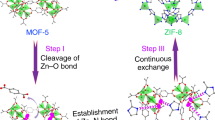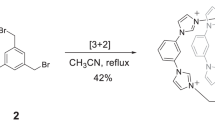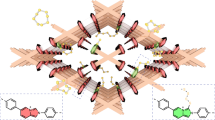Abstract
The use of coordination complexes within covalent organic frameworks can significantly diversify the structures and properties of this class of materials. Here we combined coordination chemistry and reticular chemistry by preparing frameworks that consist of a ditopic (p-phenylenediamine) and mixed tritopic moieties—an organic ligand and a scandium coordination complex of similar sizes and geometries, both bearing terminal phenylamine groups. Changing the ratio of organic ligand to scandium complex enabled the preparation of a series of crystalline covalent organic frameworks with tunable levels of scandium incorporation. Removal of scandium from the material with the highest metal content subsequently resulted in a ‘metal-imprinted’ covalent organic framework that exhibits a high affinity and capacity for Sc3+ ions in acidic environments and in the presence of competing metal ions. In particular, the selectivity of this framework for Sc3+ over common impurity ions such as La3+ and Fe3+ surpasses that of existing scandium adsorbents.

This is a preview of subscription content, access via your institution
Access options
Access Nature and 54 other Nature Portfolio journals
Get Nature+, our best-value online-access subscription
$29.99 / 30 days
cancel any time
Subscribe to this journal
Receive 12 print issues and online access
$259.00 per year
only $21.58 per issue
Buy this article
- Purchase on Springer Link
- Instant access to full article PDF
Prices may be subject to local taxes which are calculated during checkout




Similar content being viewed by others
Data availability
The authors declare that the main data supporting the findings of this study can be accessed at https://doi.org/10.6084/m9.figshare.19602262 (ref. 45). Source data are provided with this paper.
References
Yasukawa, K. et al. A new and prospective resource for scandium: evidence from the geochemistry of deep-sea sediment in the western North Pacific Ocean. Ore Geol. Rev. 102, 260–267 (2018).
Wang, W., Pranolo, Y. & Cheng, C. Y. Metallurgical processes for scandium recovery from various resources: a review. Hydrometallurgy 108, 100–108 (2011).
Wang, W. & Cheng, C. Y. Separation and purification of scandium by solvent extraction and related technologies: a review. J. Chem. Technol. Biot. 86, 1237–1246 (2011).
Chassé, M., Griffin, W. L., O’Reilly, S. Y. & Calas, G. Scandium speciation in a world-class lateritic deposit. Geochem. Persp. Lett. 3, 105–114 (2017).
Zhang, P., You, S., Zhang, L., Feng, S. & Hou, S. A solvent extraction process for the preparation of ultrahigh purity scandium oxide. Hydrometallurgy 47, 47–56 (1997).
Wilson, A. M. et al. Solvent extraction: the coordination chemistry behind extractive metallurgy. Chem. Soc. Rev. 43, 123–134 (2014).
Li, J., Chen, C., Zhang, R. & Wang, X. Reductive immobilization of Re(VII) by graphene modified nanoscale zero-valent iron particles using a plasma technique. Sci. China Chem. 59, 150–158 (2016).
Botelho Junior, A. B., Espinosa, D. C. R., Vaughan, J. & Tenório, J. A. S. Recovery of scandium from various sources: a critical review of the state of the art and future prospects. Miner. Eng. 172, 107148 (2021).
Ahmad, Z. The properties and application of scandium-reinforced aluminum. JOM 55, 35–39 (2003).
Das, S. et al. Extraction of scandium(III) from acidic solutions using organo-phosphoric acid reagents: a comparative study. Sep. Purif. Technol. 202, 248–258 (2018).
Makanyire, T., Sanchez-Segado, S. & Jha, A. Separation and recovery of critical metal ions using ionic liquids. Adv. Manuf. 4, 33–46 (2016).
Onghena, B. & Binnemans, K. Recovery of scandium(III) from aqueous solutions by solvent extraction with the functionalized ionic liquid betainium bis(trifluoromethylsulfonyl)imide. Ind. Eng. Chem. Res. 54, 1887–1898 (2015).
Tu, Z. et al. Silica gel modified with 1-(2-aminoethyl)-3-phenylurea for selective solid-phase extraction and preconcentration of Sc(III) from environmental samples. Talanta 80, 1205–1209 (2010).
Ramasamy, D. L., Puhakka, V., Doshi, B., Iftekhar, S. & Sillanpää, M. Fabrication of carbon nanotubes reinforced silica composites with improved rare earth elements adsorption performance. Chem. Eng. J. 365, 291–304 (2019).
Peng, Y. et al. A versatile MOF-based trap for heavy metal ion capture and dispersion. Nat. Commun. 9, 187 (2018).
Yuan, Y. & Zhu, G. Porous aromatic frameworks as a platform for multifunctional applications. ACS Cent. Sci. 5, 409–418 (2019).
Diercks, C. S. & Yaghi, O. M. The atom, the molecule, and the covalent organic framework. Science 355, eaal1585 (2017).
Yue, J.-Y. et al. Metal ion-assisted carboxyl-containing covalent organic frameworks for the efficient removal of Congo red. Dalton Trans. 48, 17763–17769 (2019).
Lu, Q. et al. Postsynthetic functionalization of three-dimensional covalent organic frameworks for selective extraction of lanthanide ions. Angew. Chem. Int. Ed. 57, 6042–6048 (2018).
Huang, N., Zhai, L., Xu, H. & Jiang, D. Stable covalent organic frameworks for exceptional mercury removal from aqueous solutions. J. Am. Chem. Soc. 139, 2428–2434 (2017).
Sun, Q. et al. Postsynthetically modified covalent organic frameworks for efficient and effective mercury removal. J. Am. Chem. Soc. 139, 2786–2793 (2017).
Jiang, Y., Liu, C. & Huang, A. EDTA-functionalized covalent organic framework for the removal of heavy-metal ions. ACS Appl. Mater. Interfaces 11, 32186–32191 (2019).
Feng, X., Ding, X. & Jiang, D. Covalent organic frameworks. Chem. Soc. Rev. 41, 6010–6022 (2012).
Dong, J., Han, X., Liu, Y., Li, H. & Cui, Y. Metal–covalent organic frameworks (MCOFs): a bridge between metal–organic frameworks and covalent organic frameworks. Angew. Chem. Int. Ed. 59, 2–14 (2020).
Chen, L., Wang, X., Lu, W., Wu, X. & Li, J. Molecular imprinting: perspectives and applications. Chem. Soc. Rev. 45, 2137–2211 (2016).
Yuan, Y., Yang, Y. & Zhu, G. Molecularly imprinted porous aromatic frameworks for molecular recognition. ACS Cent. Sci. 6, 1082–1094 (2020).
Guo, Z. et al. Molecularly imprinted polymer/metal organic framework based chemical sensors. Coatings 6, 42 (2016).
Kandambeth, S. et al. Construction of crystalline 2D covalent organic frameworks with remarkable chemical (acid/base) stability via a combined reversible and irreversible route. J. Am. Chem. Soc. 134, 19524–19527 (2012).
Parashar, G. K. & Rai, A. K. Synthesis, molecular weights and infrared spectra of some scandium(III) higher carboxylates. Transit. Met. Chem. 3, 49–50 (1978).
Rai, A. K. & Parashar, G. K. Synthesis and structural studies of some scandium(III) carboxylates. Synth. React. Inorg. Met. Org. Chem. 9, 301–307 (1979).
Zhang, X., Kumar, R. & Kuroda, D. G. Acetate ion and its interesting solvation shell structure and dynamics. J. Chem. Phys. 148, 094506 (2018).
Anderson, T., Neuman, M. & Melson, G. Coordination chemistry of scandium. VI. Crystal and molecular structure of tris(tropolonato)scandium(III). Stereochemistry of some six-coordinate complexes. Inorg. Chem. 13, 158–163 (1974).
Holder, C. F. & Schaak, R. E. Tutorial on powder X-ray diffraction for characterizing nanoscale materials. ACS Nano 13, 7359–7365 (2019).
Ravikovitcha, P. I., Haller, G. L. & Neimark, A. V. Density functional theory model for calculating pore size distributions: pore structure of nanoporous catalysts. Adv. Colloid Interface Sci. 76–77, 203–226 (1998).
Jiang, J., Zhao, Y. & Yaghi, O. M. Covalent chemistry beyond molecules. J. Am. Chem. Soc. 138, 3255–3265 (2016).
Zhang, N., Huang, C. & Hu, B. ICP-AES determination of trace rare earth elements in environmental and food samples by on-line separation and preconcentration with acetylacetone-modified silica gel using microcolumn. Anal. Sci. 23, 997–1002 (2007).
Iftekhar, S., Srivastava, V. & Sillanpää, M. Enrichment of lanthanides in aqueous system by cellulose based silica nanocomposite. Chem. Eng. J. 320, 151–159 (2017).
Ramasamy, D., Puhakka, V., Repo, E., Khan, S. & Sillanpää, M. Coordination and silica surface chemistry of lanthanides (III), scandium (III) and yttrium (III) sorption on 1-(2-pyridylazo)-2-napththol (PAN) and acetylacetone (acac) immobilized gels. Chem. Eng. J. 324, 104–112 (2017).
Wang, W., Pranolo, Y. & Cheng, C. Y. Metallurgical processes for scandium recovery from various resources: a review. Hydrometallurgy 108, 100–108 (2011).
Shannon, R. D. Revised effective ionic radii and systematic studies of interatomic distances in halides and chalcogenides. Acta Cryst. A32, 751–767 (1976).
Frisch, M. J. et al. Gaussian 16, Revision C (Gaussian, 2016).
Wei, D. et al. Adsorption properties of hydrated Cr3+ ions on Schiff-base covalent organic frameworks: a DFT study. Chem. Asian J. 15, 1140–1146 (2020).
Spedding, F. H. & Croat, J. J. Magnetic properties of high purity scandium and the effect of impurities on these properties. J. Chem. Phys. 58, 5514–5526 (1973).
Bunzli, J.-C. G. & Choppin, G. R. (eds) Lanthanide Probes in Life, Chemical and Earth Sciences (Elsevier, 1989).
Yaun, Y. Data for selective scandium ion capture through coordination templating in a covalent organic framework. figshare https://figshare.com/s/307112ae4822adc40e38 (2023).
Acknowledgements
G.Z. was supported by the National Key R&D Program of China (grant no. 2022YFB3805902), the National Natural Science Foundation of China (grant nos 22131004 and U21A20330) and the ‘111’ project (grant no. B18012). Y. Yang was supported by the National Natural Science Foundation of China (grant no. 52204389). Y. Yuan was supported by the National Natural Science Foundation of China (grant no. 21975039) and the Fundamental Research Funds for the Central Universities, Excellent Youth Team Program (grant no. 2412023YQ001). K.R.M. and J.R.L. were supported by the US Department of Energy, Office of Science, Office of Basic Energy Sciences under award DE-SC0019992.
Author information
Authors and Affiliations
Contributions
Y. Yang carried out the experiments, performed the data interpretation and draughted the initial manuscript. X.G. and W.Z. collected and analysed the TEM and STEM data. J.R.L. and K.R.M. helped design the experiments and wrote portions of the manuscript. S.Z. and R.F. performed the theoretical calculations. Y. Yuan and G.Z. developed the concept, supervised the experiments and draughted the manuscript.
Corresponding authors
Ethics declarations
Competing interests
The authors declare no competing interests.
Peer review
Peer review information
Nature Chemistry thanks Shengqian Ma, Dan Zhao and the other, anonymous, reviewer(s) for their contribution to the peer review of this work.
Additional information
Publisher’s note Springer Nature remains neutral with regard to jurisdictional claims in published maps and institutional affiliations.
Supplementary information
Supplementary Information
Supplementary Figs. 1–26, Tables 1–14 and Discussion.
Source data
Source Data Fig. 2
Source data for Fig. 2a,c.
Source Data Fig. 3
Source data for Fig. 3a–d.
Source Data Fig. 4
Source data for Fig. 4a.
Rights and permissions
Springer Nature or its licensor (e.g. a society or other partner) holds exclusive rights to this article under a publishing agreement with the author(s) or other rightsholder(s); author self-archiving of the accepted manuscript version of this article is solely governed by the terms of such publishing agreement and applicable law.
About this article
Cite this article
Yuan, Y., Yang, Y., Meihaus, K.R. et al. Selective scandium ion capture through coordination templating in a covalent organic framework. Nat. Chem. 15, 1599–1606 (2023). https://doi.org/10.1038/s41557-023-01273-3
Received:
Accepted:
Published:
Issue Date:
DOI: https://doi.org/10.1038/s41557-023-01273-3
This article is cited by
-
Precisely modulating covalent and coordination bonds in the porous network for highly selective metal ion extraction
Science China Chemistry (2024)
-
Selective scandium ion capture through coordination templating in a covalent organic framework
Nature Chemistry (2023)



